Management Accounting Report: Analysis of Imda Tech Limited Operations
VerifiedAdded on 2019/12/04
|16
|4414
|458
Report
AI Summary
This report offers a comprehensive overview of management accounting principles, using Imda Tech Limited as a case study. It delves into key concepts such as management accounting, its types, and its significance in decision-making. The report details the differences between financial and management accounting, emphasizing the role of management accounting information for administrative section managers. It explores various costing methods, including absorption and marginal costing, providing calculations and income statements for each. Additionally, the report covers different types of budgets, their pros and cons, and the relevance of valuation in budget formation, along with the process of budget preparation and pricing strategies. Furthermore, it discusses the importance of scorecards in organizational performance measurement. The analysis includes detailed calculations and comparisons, making it a valuable resource for understanding management accounting practices. The report is available on Desklib, a platform providing AI-based study tools for students.
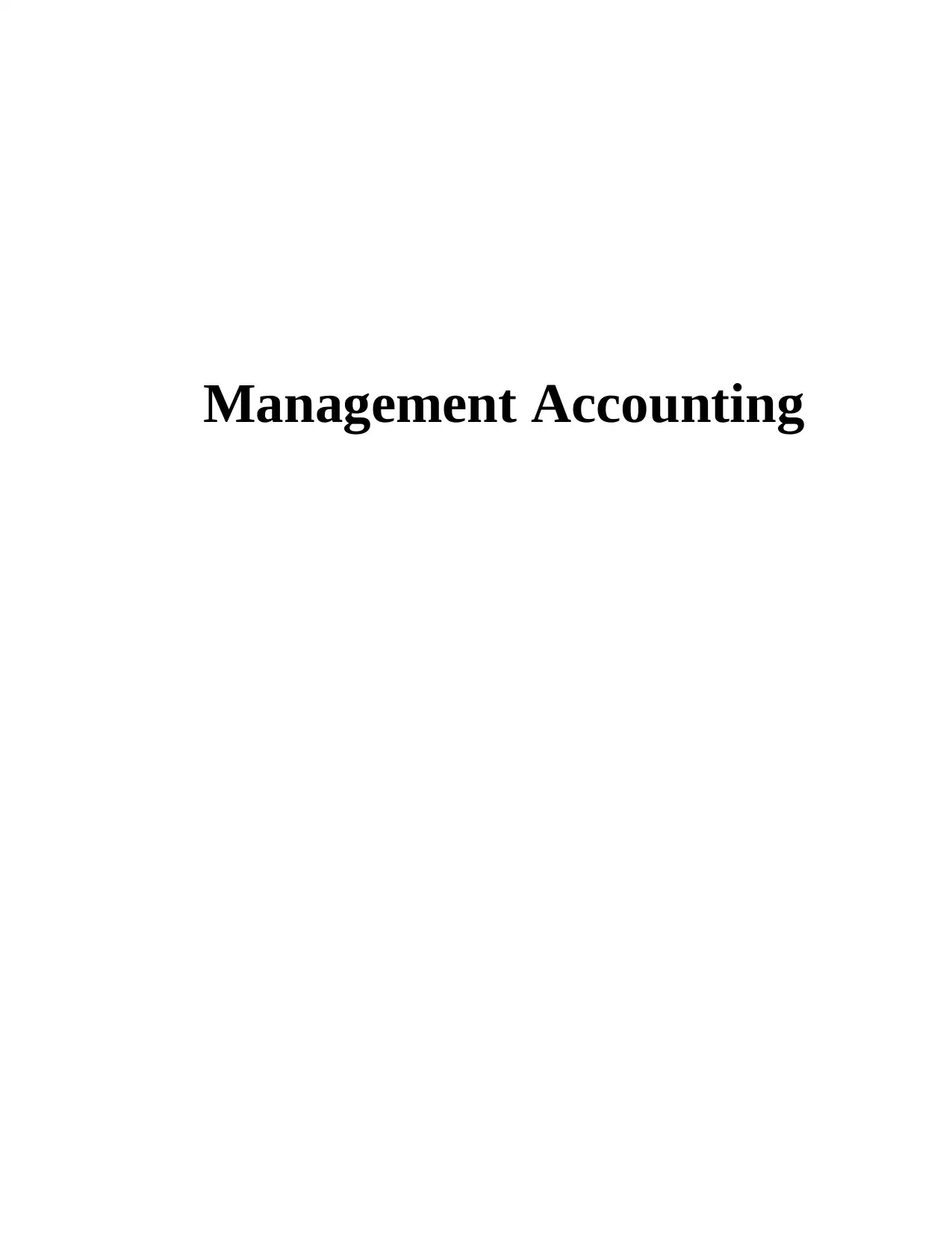
Management Accounting
Paraphrase This Document
Need a fresh take? Get an instant paraphrase of this document with our AI Paraphraser
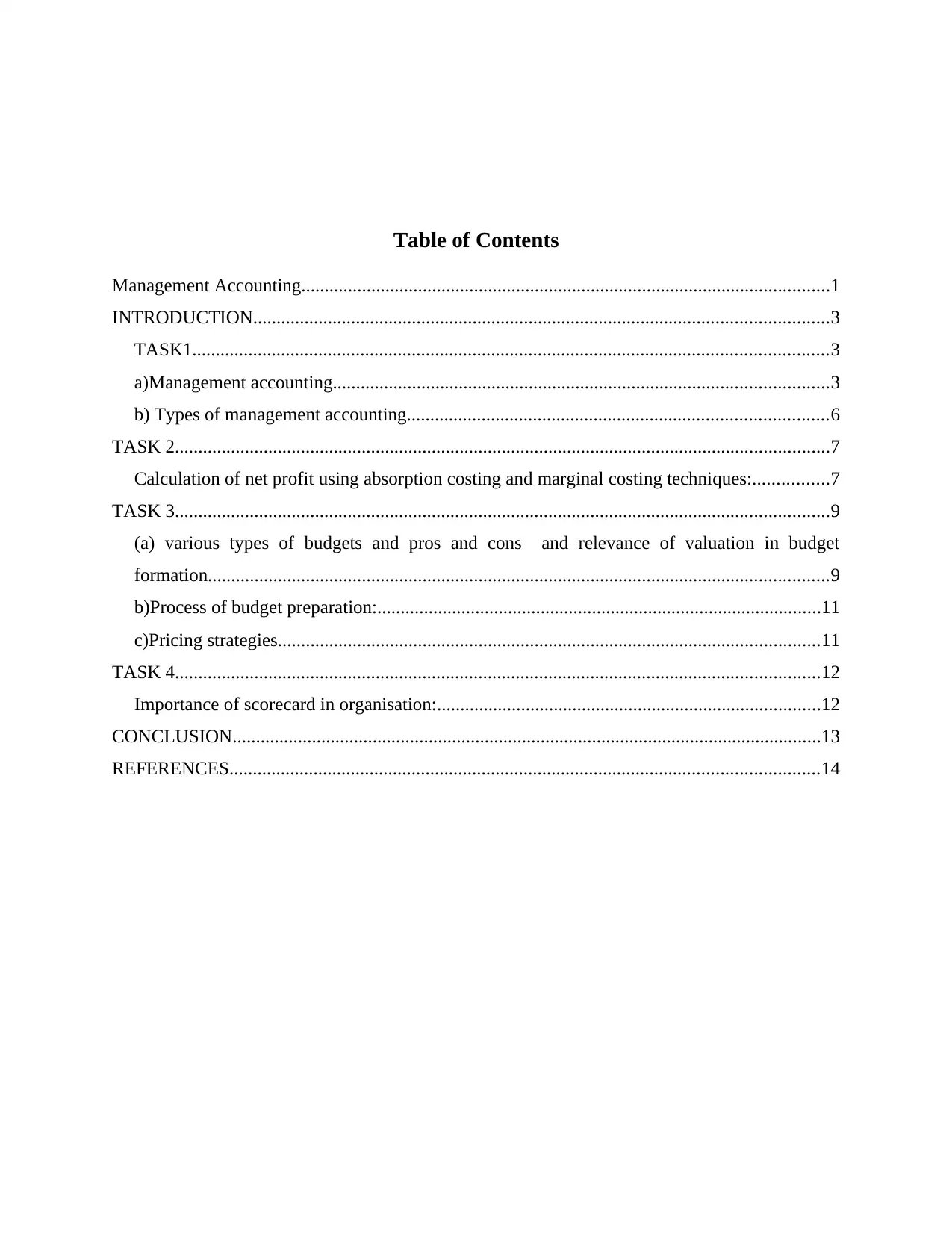
Table of Contents
Management Accounting.................................................................................................................1
INTRODUCTION...........................................................................................................................3
TASK1........................................................................................................................................3
a)Management accounting..........................................................................................................3
b) Types of management accounting..........................................................................................6
TASK 2............................................................................................................................................7
Calculation of net profit using absorption costing and marginal costing techniques:................7
TASK 3............................................................................................................................................9
(a) various types of budgets and pros and cons and relevance of valuation in budget
formation.....................................................................................................................................9
b)Process of budget preparation:...............................................................................................11
c)Pricing strategies....................................................................................................................11
TASK 4..........................................................................................................................................12
Importance of scorecard in organisation:..................................................................................12
CONCLUSION..............................................................................................................................13
REFERENCES..............................................................................................................................14
Management Accounting.................................................................................................................1
INTRODUCTION...........................................................................................................................3
TASK1........................................................................................................................................3
a)Management accounting..........................................................................................................3
b) Types of management accounting..........................................................................................6
TASK 2............................................................................................................................................7
Calculation of net profit using absorption costing and marginal costing techniques:................7
TASK 3............................................................................................................................................9
(a) various types of budgets and pros and cons and relevance of valuation in budget
formation.....................................................................................................................................9
b)Process of budget preparation:...............................................................................................11
c)Pricing strategies....................................................................................................................11
TASK 4..........................................................................................................................................12
Importance of scorecard in organisation:..................................................................................12
CONCLUSION..............................................................................................................................13
REFERENCES..............................................................................................................................14
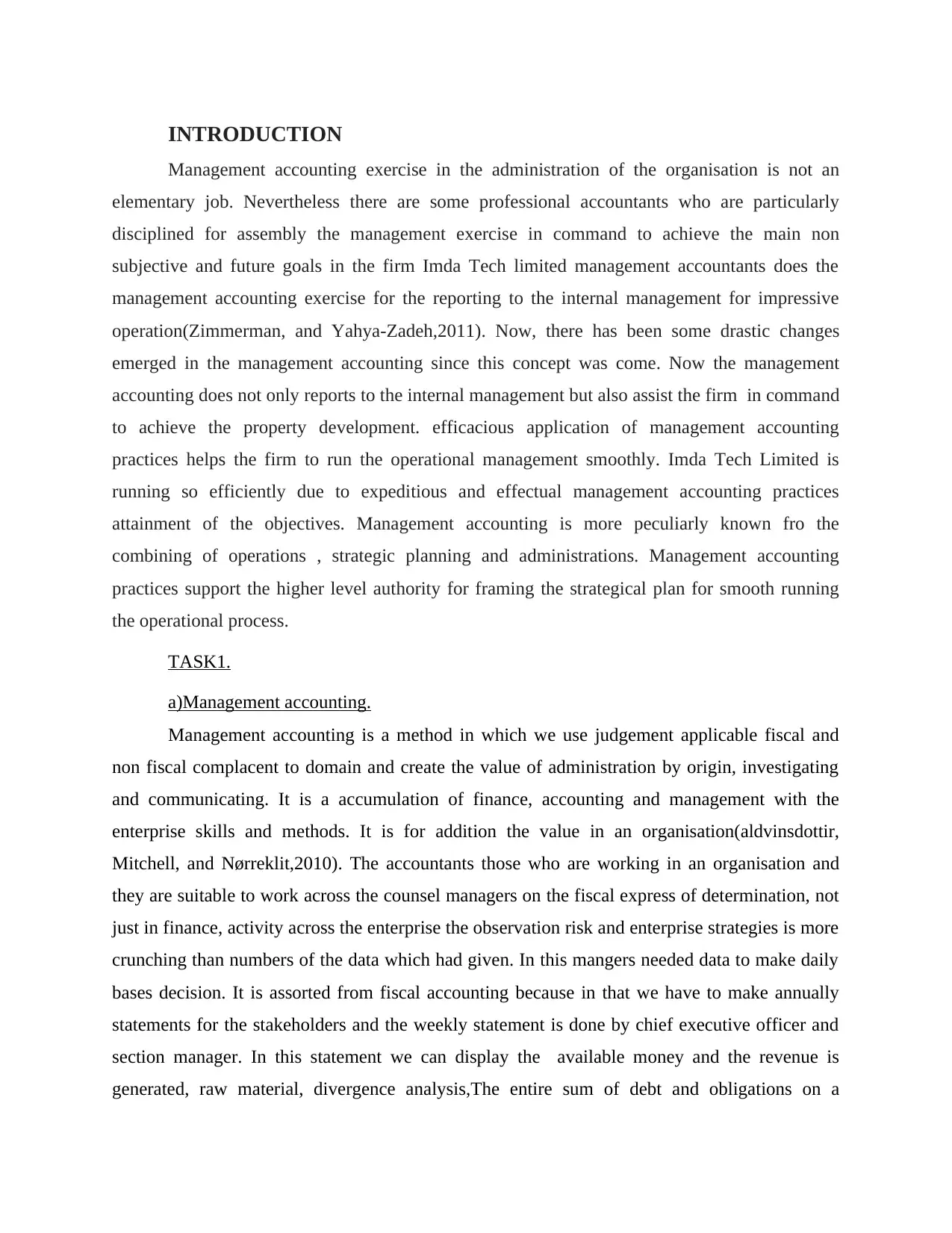
INTRODUCTION
Management accounting exercise in the administration of the organisation is not an
elementary job. Nevertheless there are some professional accountants who are particularly
disciplined for assembly the management exercise in command to achieve the main non
subjective and future goals in the firm Imda Tech limited management accountants does the
management accounting exercise for the reporting to the internal management for impressive
operation(Zimmerman, and Yahya-Zadeh,2011). Now, there has been some drastic changes
emerged in the management accounting since this concept was come. Now the management
accounting does not only reports to the internal management but also assist the firm in command
to achieve the property development. efficacious application of management accounting
practices helps the firm to run the operational management smoothly. Imda Tech Limited is
running so efficiently due to expeditious and effectual management accounting practices
attainment of the objectives. Management accounting is more peculiarly known fro the
combining of operations , strategic planning and administrations. Management accounting
practices support the higher level authority for framing the strategical plan for smooth running
the operational process.
TASK1.
a)Management accounting.
Management accounting is a method in which we use judgement applicable fiscal and
non fiscal complacent to domain and create the value of administration by origin, investigating
and communicating. It is a accumulation of finance, accounting and management with the
enterprise skills and methods. It is for addition the value in an organisation(aldvinsdottir,
Mitchell, and Nørreklit,2010). The accountants those who are working in an organisation and
they are suitable to work across the counsel managers on the fiscal express of determination, not
just in finance, activity across the enterprise the observation risk and enterprise strategies is more
crunching than numbers of the data which had given. In this mangers needed data to make daily
bases decision. It is assorted from fiscal accounting because in that we have to make annually
statements for the stakeholders and the weekly statement is done by chief executive officer and
section manager. In this statement we can display the available money and the revenue is
generated, raw material, divergence analysis,The entire sum of debt and obligations on a
Management accounting exercise in the administration of the organisation is not an
elementary job. Nevertheless there are some professional accountants who are particularly
disciplined for assembly the management exercise in command to achieve the main non
subjective and future goals in the firm Imda Tech limited management accountants does the
management accounting exercise for the reporting to the internal management for impressive
operation(Zimmerman, and Yahya-Zadeh,2011). Now, there has been some drastic changes
emerged in the management accounting since this concept was come. Now the management
accounting does not only reports to the internal management but also assist the firm in command
to achieve the property development. efficacious application of management accounting
practices helps the firm to run the operational management smoothly. Imda Tech Limited is
running so efficiently due to expeditious and effectual management accounting practices
attainment of the objectives. Management accounting is more peculiarly known fro the
combining of operations , strategic planning and administrations. Management accounting
practices support the higher level authority for framing the strategical plan for smooth running
the operational process.
TASK1.
a)Management accounting.
Management accounting is a method in which we use judgement applicable fiscal and
non fiscal complacent to domain and create the value of administration by origin, investigating
and communicating. It is a accumulation of finance, accounting and management with the
enterprise skills and methods. It is for addition the value in an organisation(aldvinsdottir,
Mitchell, and Nørreklit,2010). The accountants those who are working in an organisation and
they are suitable to work across the counsel managers on the fiscal express of determination, not
just in finance, activity across the enterprise the observation risk and enterprise strategies is more
crunching than numbers of the data which had given. In this mangers needed data to make daily
bases decision. It is assorted from fiscal accounting because in that we have to make annually
statements for the stakeholders and the weekly statement is done by chief executive officer and
section manager. In this statement we can display the available money and the revenue is
generated, raw material, divergence analysis,The entire sum of debt and obligations on a
⊘ This is a preview!⊘
Do you want full access?
Subscribe today to unlock all pages.

Trusted by 1+ million students worldwide
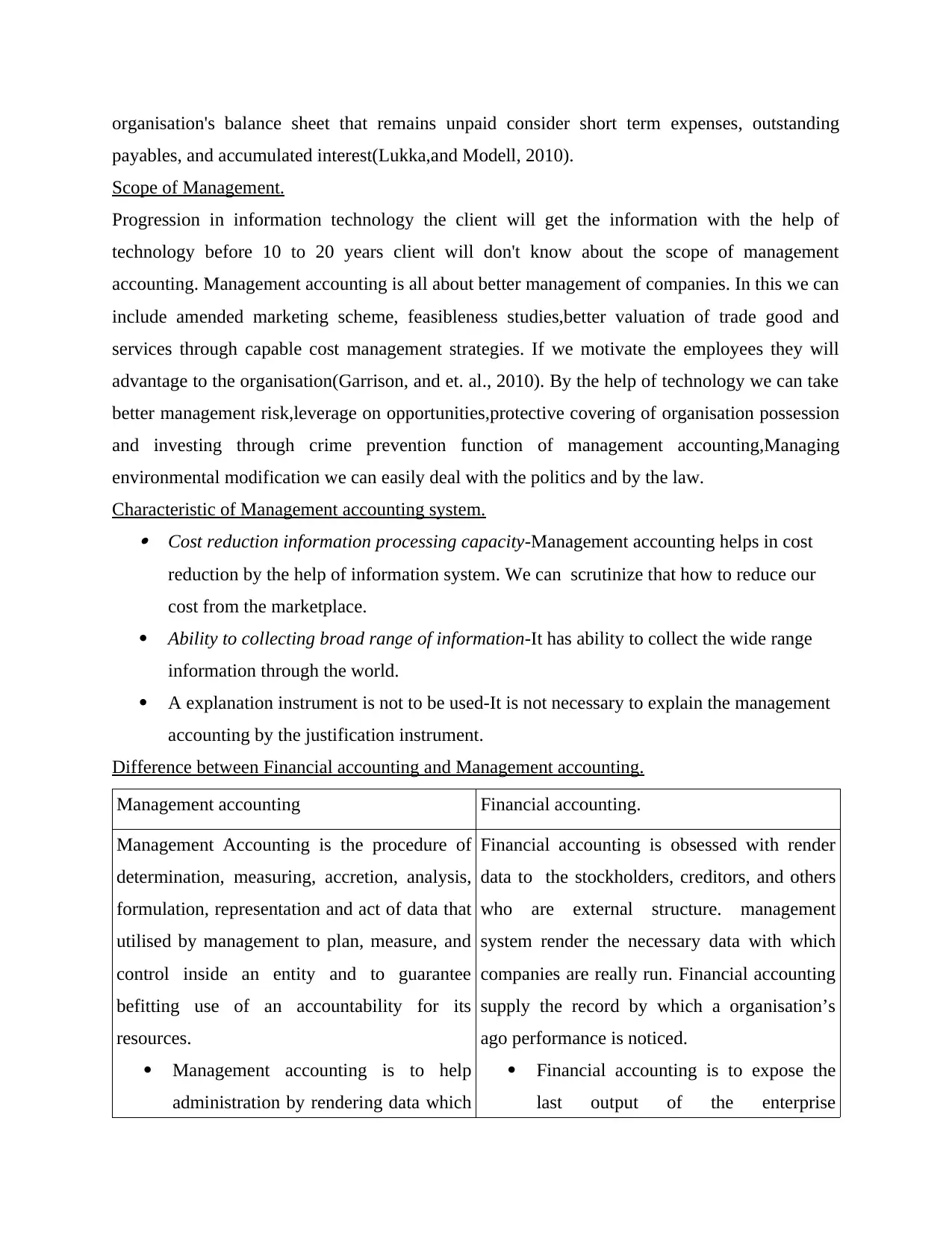
organisation's balance sheet that remains unpaid consider short term expenses, outstanding
payables, and accumulated interest(Lukka,and Modell, 2010).
Scope of Management.
Progression in information technology the client will get the information with the help of
technology before 10 to 20 years client will don't know about the scope of management
accounting. Management accounting is all about better management of companies. In this we can
include amended marketing scheme, feasibleness studies,better valuation of trade good and
services through capable cost management strategies. If we motivate the employees they will
advantage to the organisation(Garrison, and et. al., 2010). By the help of technology we can take
better management risk,leverage on opportunities,protective covering of organisation possession
and investing through crime prevention function of management accounting,Managing
environmental modification we can easily deal with the politics and by the law.
Characteristic of Management accounting system. Cost reduction information processing capacity-Management accounting helps in cost
reduction by the help of information system. We can scrutinize that how to reduce our
cost from the marketplace.
Ability to collecting broad range of information-It has ability to collect the wide range
information through the world.
A explanation instrument is not to be used-It is not necessary to explain the management
accounting by the justification instrument.
Difference between Financial accounting and Management accounting.
Management accounting Financial accounting.
Management Accounting is the procedure of
determination, measuring, accretion, analysis,
formulation, representation and act of data that
utilised by management to plan, measure, and
control inside an entity and to guarantee
befitting use of an accountability for its
resources.
Management accounting is to help
administration by rendering data which
Financial accounting is obsessed with render
data to the stockholders, creditors, and others
who are external structure. management
system render the necessary data with which
companies are really run. Financial accounting
supply the record by which a organisation’s
ago performance is noticed.
Financial accounting is to expose the
last output of the enterprise
payables, and accumulated interest(Lukka,and Modell, 2010).
Scope of Management.
Progression in information technology the client will get the information with the help of
technology before 10 to 20 years client will don't know about the scope of management
accounting. Management accounting is all about better management of companies. In this we can
include amended marketing scheme, feasibleness studies,better valuation of trade good and
services through capable cost management strategies. If we motivate the employees they will
advantage to the organisation(Garrison, and et. al., 2010). By the help of technology we can take
better management risk,leverage on opportunities,protective covering of organisation possession
and investing through crime prevention function of management accounting,Managing
environmental modification we can easily deal with the politics and by the law.
Characteristic of Management accounting system. Cost reduction information processing capacity-Management accounting helps in cost
reduction by the help of information system. We can scrutinize that how to reduce our
cost from the marketplace.
Ability to collecting broad range of information-It has ability to collect the wide range
information through the world.
A explanation instrument is not to be used-It is not necessary to explain the management
accounting by the justification instrument.
Difference between Financial accounting and Management accounting.
Management accounting Financial accounting.
Management Accounting is the procedure of
determination, measuring, accretion, analysis,
formulation, representation and act of data that
utilised by management to plan, measure, and
control inside an entity and to guarantee
befitting use of an accountability for its
resources.
Management accounting is to help
administration by rendering data which
Financial accounting is obsessed with render
data to the stockholders, creditors, and others
who are external structure. management
system render the necessary data with which
companies are really run. Financial accounting
supply the record by which a organisation’s
ago performance is noticed.
Financial accounting is to expose the
last output of the enterprise
Paraphrase This Document
Need a fresh take? Get an instant paraphrase of this document with our AI Paraphraser
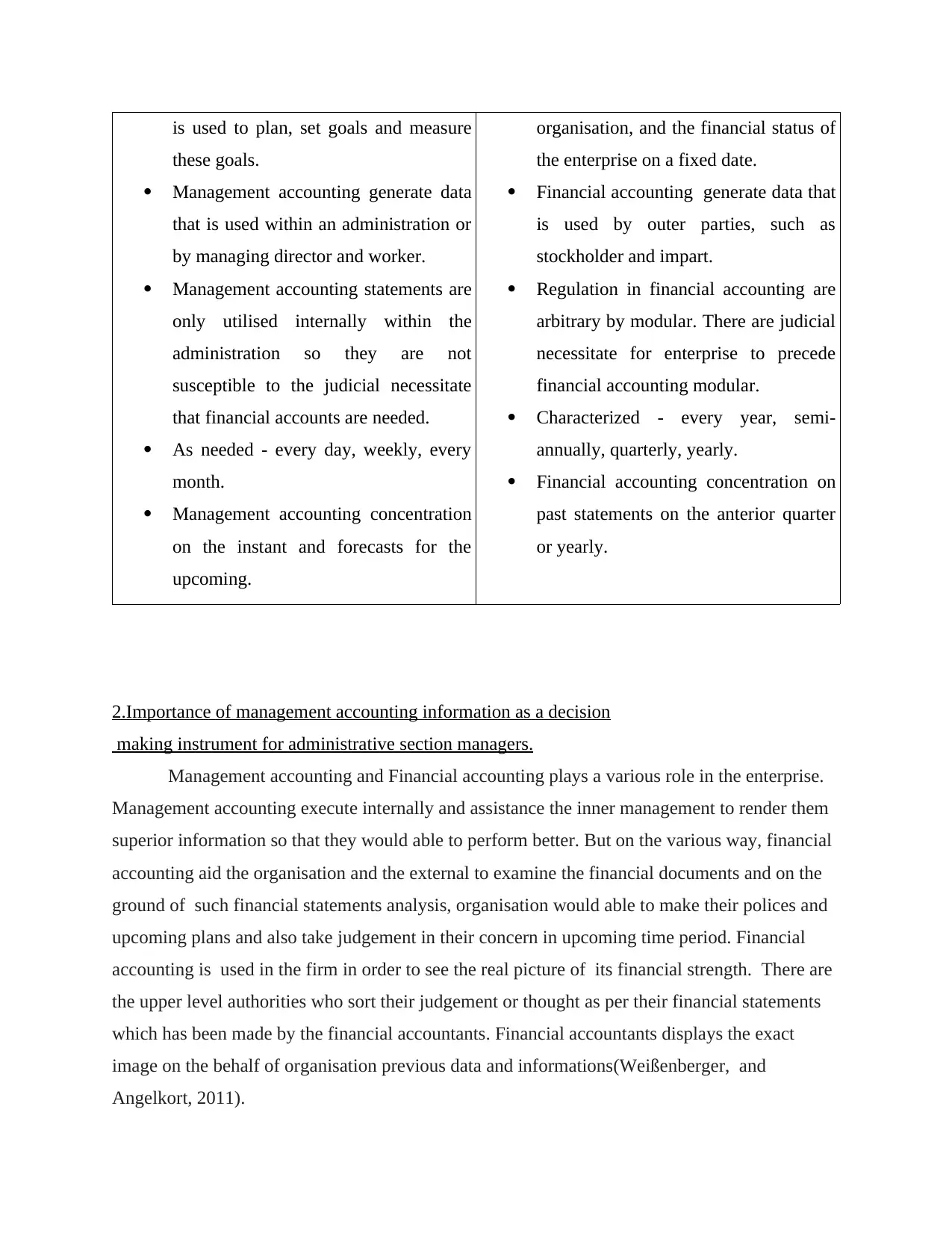
is used to plan, set goals and measure
these goals.
Management accounting generate data
that is used within an administration or
by managing director and worker.
Management accounting statements are
only utilised internally within the
administration so they are not
susceptible to the judicial necessitate
that financial accounts are needed.
As needed - every day, weekly, every
month.
Management accounting concentration
on the instant and forecasts for the
upcoming.
organisation, and the financial status of
the enterprise on a fixed date.
Financial accounting generate data that
is used by outer parties, such as
stockholder and impart.
Regulation in financial accounting are
arbitrary by modular. There are judicial
necessitate for enterprise to precede
financial accounting modular.
Characterized - every year, semi-
annually, quarterly, yearly.
Financial accounting concentration on
past statements on the anterior quarter
or yearly.
2.Importance of management accounting information as a decision
making instrument for administrative section managers.
Management accounting and Financial accounting plays a various role in the enterprise.
Management accounting execute internally and assistance the inner management to render them
superior information so that they would able to perform better. But on the various way, financial
accounting aid the organisation and the external to examine the financial documents and on the
ground of such financial statements analysis, organisation would able to make their polices and
upcoming plans and also take judgement in their concern in upcoming time period. Financial
accounting is used in the firm in order to see the real picture of its financial strength. There are
the upper level authorities who sort their judgement or thought as per their financial statements
which has been made by the financial accountants. Financial accountants displays the exact
image on the behalf of organisation previous data and informations(Weißenberger, and
Angelkort, 2011).
these goals.
Management accounting generate data
that is used within an administration or
by managing director and worker.
Management accounting statements are
only utilised internally within the
administration so they are not
susceptible to the judicial necessitate
that financial accounts are needed.
As needed - every day, weekly, every
month.
Management accounting concentration
on the instant and forecasts for the
upcoming.
organisation, and the financial status of
the enterprise on a fixed date.
Financial accounting generate data that
is used by outer parties, such as
stockholder and impart.
Regulation in financial accounting are
arbitrary by modular. There are judicial
necessitate for enterprise to precede
financial accounting modular.
Characterized - every year, semi-
annually, quarterly, yearly.
Financial accounting concentration on
past statements on the anterior quarter
or yearly.
2.Importance of management accounting information as a decision
making instrument for administrative section managers.
Management accounting and Financial accounting plays a various role in the enterprise.
Management accounting execute internally and assistance the inner management to render them
superior information so that they would able to perform better. But on the various way, financial
accounting aid the organisation and the external to examine the financial documents and on the
ground of such financial statements analysis, organisation would able to make their polices and
upcoming plans and also take judgement in their concern in upcoming time period. Financial
accounting is used in the firm in order to see the real picture of its financial strength. There are
the upper level authorities who sort their judgement or thought as per their financial statements
which has been made by the financial accountants. Financial accountants displays the exact
image on the behalf of organisation previous data and informations(Weißenberger, and
Angelkort, 2011).
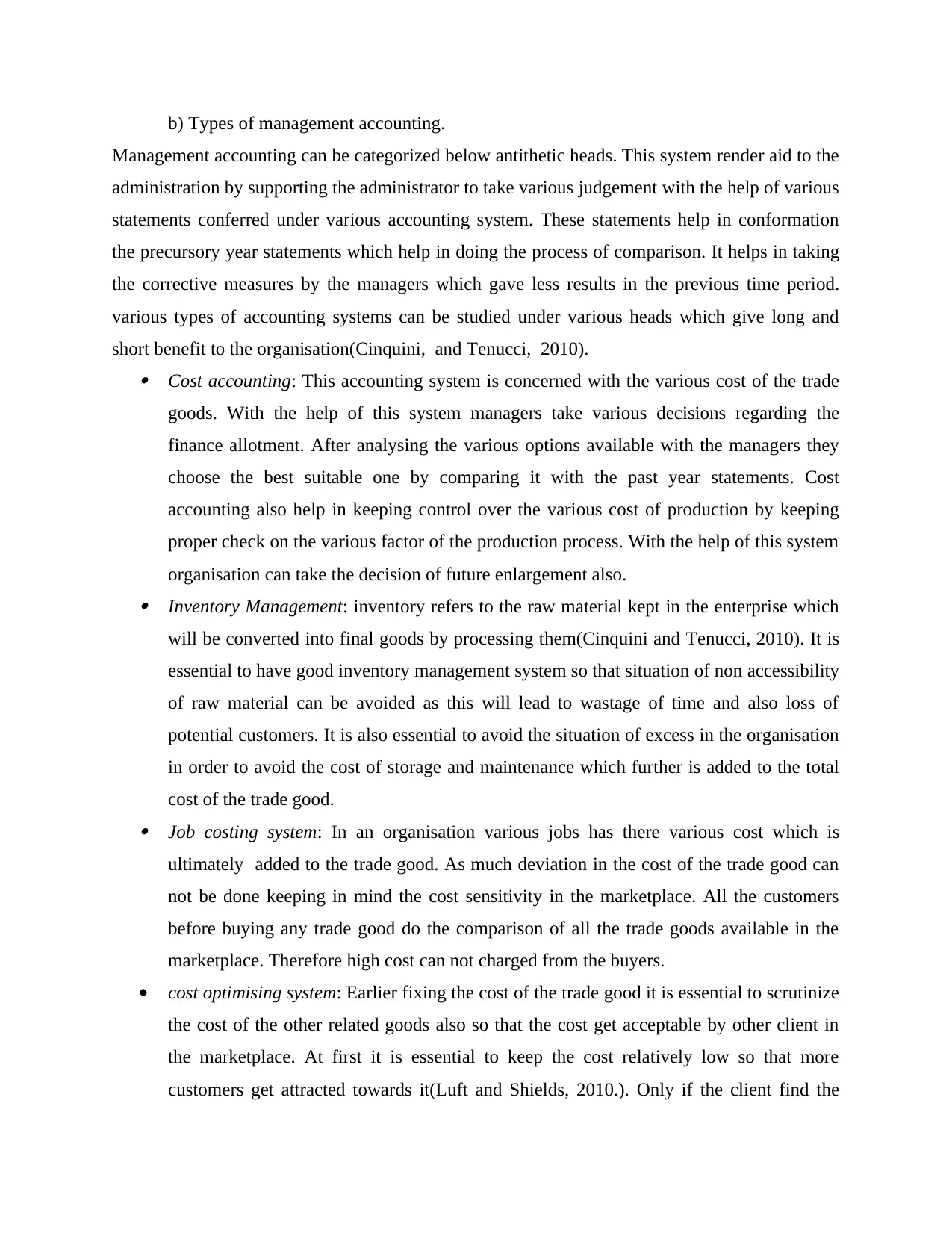
b) Types of management accounting.
Management accounting can be categorized below antithetic heads. This system render aid to the
administration by supporting the administrator to take various judgement with the help of various
statements conferred under various accounting system. These statements help in conformation
the precursory year statements which help in doing the process of comparison. It helps in taking
the corrective measures by the managers which gave less results in the previous time period.
various types of accounting systems can be studied under various heads which give long and
short benefit to the organisation(Cinquini, and Tenucci, 2010). Cost accounting: This accounting system is concerned with the various cost of the trade
goods. With the help of this system managers take various decisions regarding the
finance allotment. After analysing the various options available with the managers they
choose the best suitable one by comparing it with the past year statements. Cost
accounting also help in keeping control over the various cost of production by keeping
proper check on the various factor of the production process. With the help of this system
organisation can take the decision of future enlargement also. Inventory Management: inventory refers to the raw material kept in the enterprise which
will be converted into final goods by processing them(Cinquini and Tenucci, 2010). It is
essential to have good inventory management system so that situation of non accessibility
of raw material can be avoided as this will lead to wastage of time and also loss of
potential customers. It is also essential to avoid the situation of excess in the organisation
in order to avoid the cost of storage and maintenance which further is added to the total
cost of the trade good. Job costing system: In an organisation various jobs has there various cost which is
ultimately added to the trade good. As much deviation in the cost of the trade good can
not be done keeping in mind the cost sensitivity in the marketplace. All the customers
before buying any trade good do the comparison of all the trade goods available in the
marketplace. Therefore high cost can not charged from the buyers.
cost optimising system: Earlier fixing the cost of the trade good it is essential to scrutinize
the cost of the other related goods also so that the cost get acceptable by other client in
the marketplace. At first it is essential to keep the cost relatively low so that more
customers get attracted towards it(Luft and Shields, 2010.). Only if the client find the
Management accounting can be categorized below antithetic heads. This system render aid to the
administration by supporting the administrator to take various judgement with the help of various
statements conferred under various accounting system. These statements help in conformation
the precursory year statements which help in doing the process of comparison. It helps in taking
the corrective measures by the managers which gave less results in the previous time period.
various types of accounting systems can be studied under various heads which give long and
short benefit to the organisation(Cinquini, and Tenucci, 2010). Cost accounting: This accounting system is concerned with the various cost of the trade
goods. With the help of this system managers take various decisions regarding the
finance allotment. After analysing the various options available with the managers they
choose the best suitable one by comparing it with the past year statements. Cost
accounting also help in keeping control over the various cost of production by keeping
proper check on the various factor of the production process. With the help of this system
organisation can take the decision of future enlargement also. Inventory Management: inventory refers to the raw material kept in the enterprise which
will be converted into final goods by processing them(Cinquini and Tenucci, 2010). It is
essential to have good inventory management system so that situation of non accessibility
of raw material can be avoided as this will lead to wastage of time and also loss of
potential customers. It is also essential to avoid the situation of excess in the organisation
in order to avoid the cost of storage and maintenance which further is added to the total
cost of the trade good. Job costing system: In an organisation various jobs has there various cost which is
ultimately added to the trade good. As much deviation in the cost of the trade good can
not be done keeping in mind the cost sensitivity in the marketplace. All the customers
before buying any trade good do the comparison of all the trade goods available in the
marketplace. Therefore high cost can not charged from the buyers.
cost optimising system: Earlier fixing the cost of the trade good it is essential to scrutinize
the cost of the other related goods also so that the cost get acceptable by other client in
the marketplace. At first it is essential to keep the cost relatively low so that more
customers get attracted towards it(Luft and Shields, 2010.). Only if the client find the
⊘ This is a preview!⊘
Do you want full access?
Subscribe today to unlock all pages.

Trusted by 1+ million students worldwide
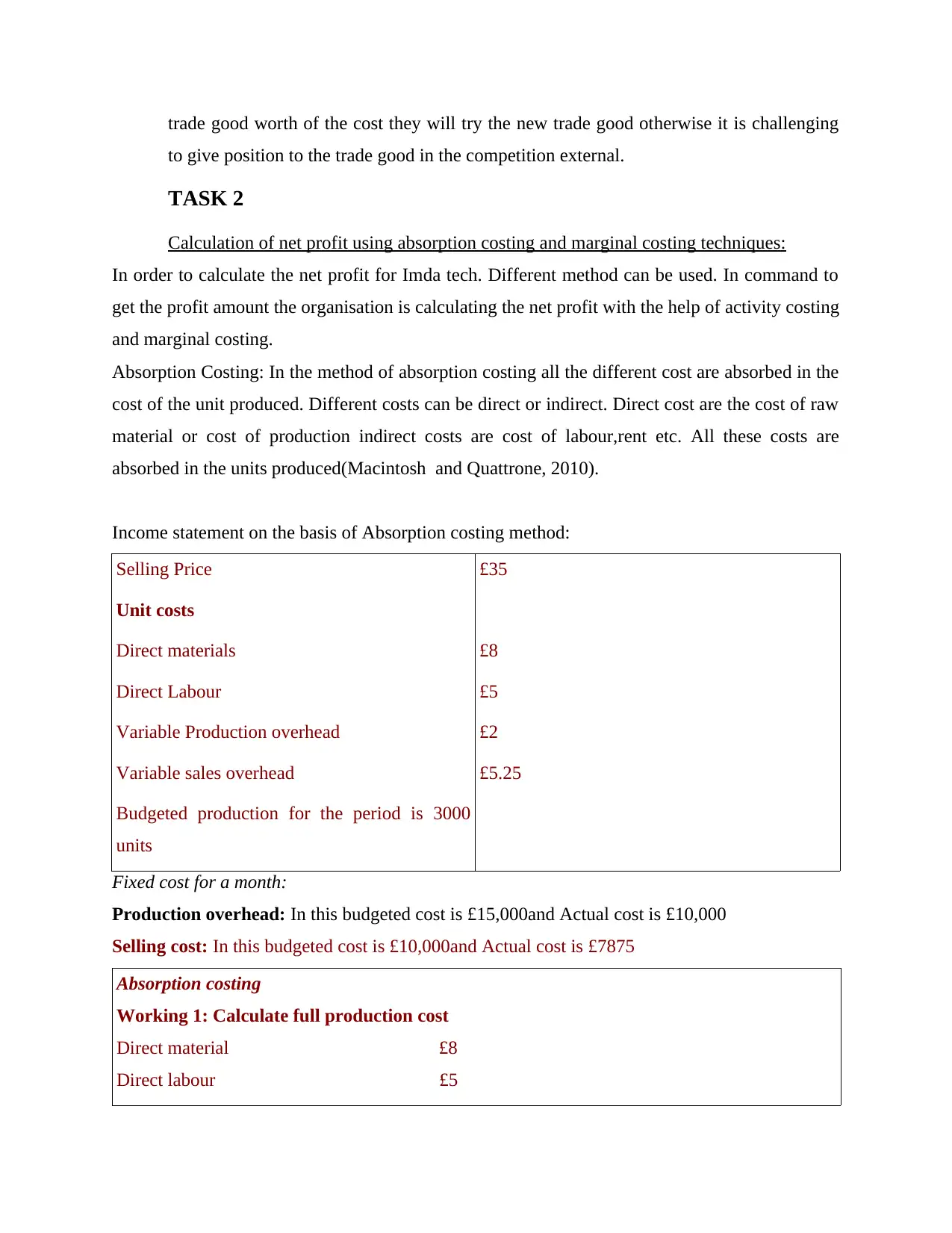
trade good worth of the cost they will try the new trade good otherwise it is challenging
to give position to the trade good in the competition external.
TASK 2
Calculation of net profit using absorption costing and marginal costing techniques:
In order to calculate the net profit for Imda tech. Different method can be used. In command to
get the profit amount the organisation is calculating the net profit with the help of activity costing
and marginal costing.
Absorption Costing: In the method of absorption costing all the different cost are absorbed in the
cost of the unit produced. Different costs can be direct or indirect. Direct cost are the cost of raw
material or cost of production indirect costs are cost of labour,rent etc. All these costs are
absorbed in the units produced(Macintosh and Quattrone, 2010).
Income statement on the basis of Absorption costing method:
Selling Price £35
Unit costs
Direct materials £8
Direct Labour £5
Variable Production overhead £2
Variable sales overhead £5.25
Budgeted production for the period is 3000
units
Fixed cost for a month:
Production overhead: In this budgeted cost is £15,000and Actual cost is £10,000
Selling cost: In this budgeted cost is £10,000and Actual cost is £7875
Absorption costing
Working 1: Calculate full production cost
Direct material £8
Direct labour £5
to give position to the trade good in the competition external.
TASK 2
Calculation of net profit using absorption costing and marginal costing techniques:
In order to calculate the net profit for Imda tech. Different method can be used. In command to
get the profit amount the organisation is calculating the net profit with the help of activity costing
and marginal costing.
Absorption Costing: In the method of absorption costing all the different cost are absorbed in the
cost of the unit produced. Different costs can be direct or indirect. Direct cost are the cost of raw
material or cost of production indirect costs are cost of labour,rent etc. All these costs are
absorbed in the units produced(Macintosh and Quattrone, 2010).
Income statement on the basis of Absorption costing method:
Selling Price £35
Unit costs
Direct materials £8
Direct Labour £5
Variable Production overhead £2
Variable sales overhead £5.25
Budgeted production for the period is 3000
units
Fixed cost for a month:
Production overhead: In this budgeted cost is £15,000and Actual cost is £10,000
Selling cost: In this budgeted cost is £10,000and Actual cost is £7875
Absorption costing
Working 1: Calculate full production cost
Direct material £8
Direct labour £5
Paraphrase This Document
Need a fresh take? Get an instant paraphrase of this document with our AI Paraphraser
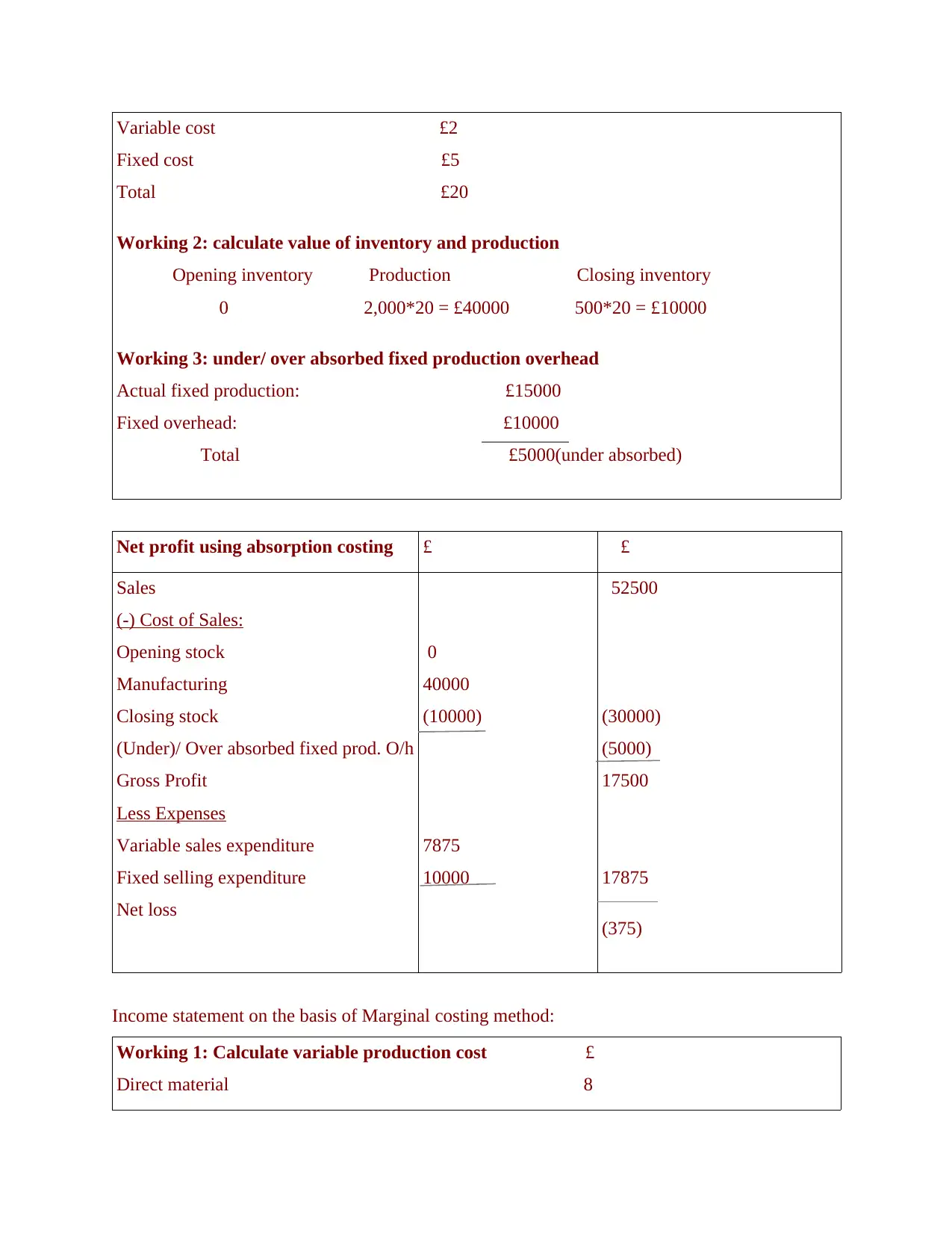
Variable cost £2
Fixed cost £5
Total £20
Working 2: calculate value of inventory and production
Opening inventory Production Closing inventory
0 2,000*20 = £40000 500*20 = £10000
Working 3: under/ over absorbed fixed production overhead
Actual fixed production: £15000
Fixed overhead: £10000
Total £5000(under absorbed)
Net profit using absorption costing £ £
Sales
(-) Cost of Sales:
Opening stock
Manufacturing
Closing stock
(Under)/ Over absorbed fixed prod. O/h
Gross Profit
Less Expenses
Variable sales expenditure
Fixed selling expenditure
Net loss
0
40000
(10000)
7875
10000
52500
(30000)
(5000)
17500
17875
(375)
Income statement on the basis of Marginal costing method:
Working 1: Calculate variable production cost £
Direct material 8
Fixed cost £5
Total £20
Working 2: calculate value of inventory and production
Opening inventory Production Closing inventory
0 2,000*20 = £40000 500*20 = £10000
Working 3: under/ over absorbed fixed production overhead
Actual fixed production: £15000
Fixed overhead: £10000
Total £5000(under absorbed)
Net profit using absorption costing £ £
Sales
(-) Cost of Sales:
Opening stock
Manufacturing
Closing stock
(Under)/ Over absorbed fixed prod. O/h
Gross Profit
Less Expenses
Variable sales expenditure
Fixed selling expenditure
Net loss
0
40000
(10000)
7875
10000
52500
(30000)
(5000)
17500
17875
(375)
Income statement on the basis of Marginal costing method:
Working 1: Calculate variable production cost £
Direct material 8
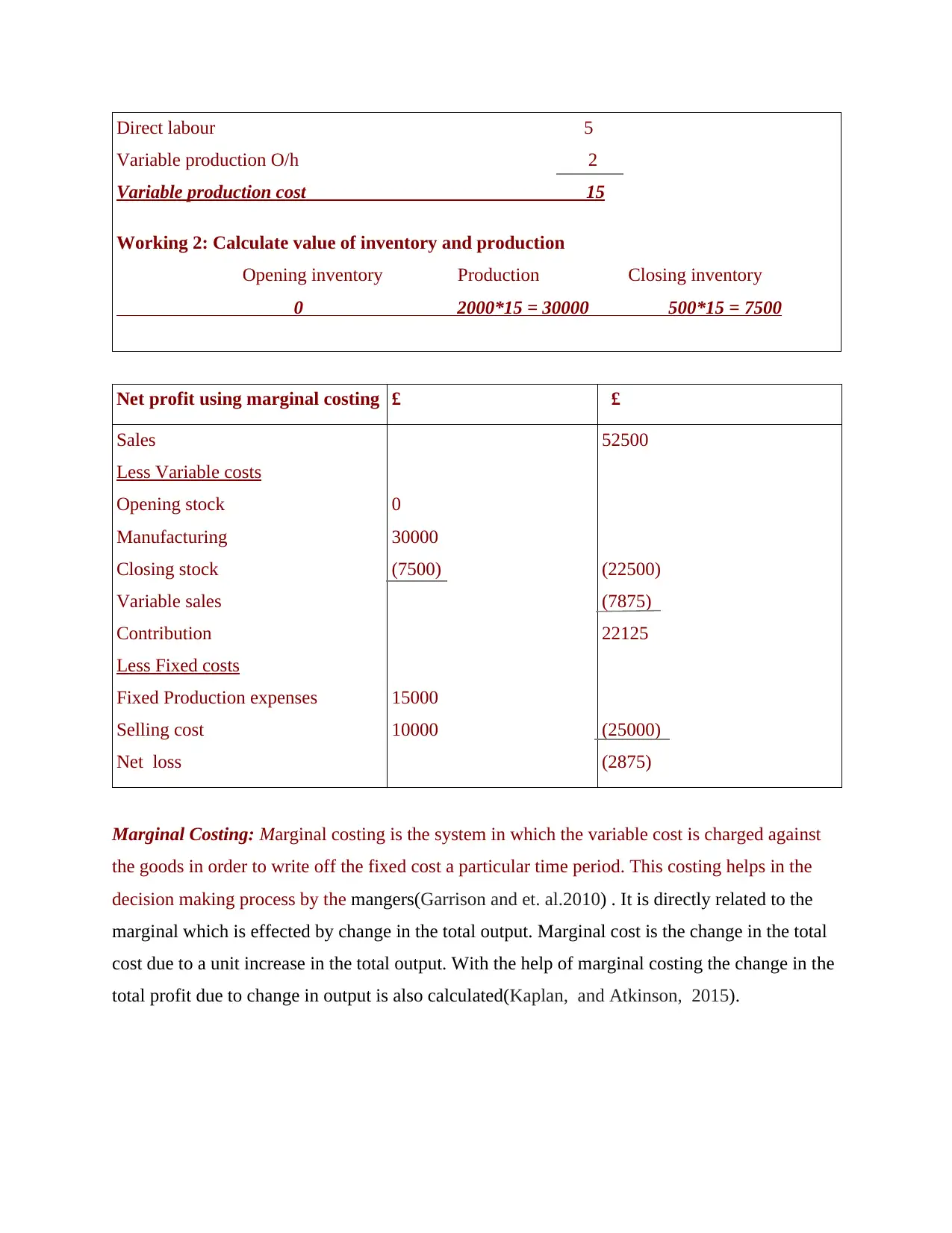
Direct labour 5
Variable production O/h 2
Variable production cost 15
Working 2: Calculate value of inventory and production
Opening inventory Production Closing inventory
0 2000*15 = 30000 500*15 = 7500
Net profit using marginal costing £ £
Sales
Less Variable costs
Opening stock
Manufacturing
Closing stock
Variable sales
Contribution
Less Fixed costs
Fixed Production expenses
Selling cost
Net loss
0
30000
(7500)
15000
10000
52500
(22500)
(7875)
22125
(25000)
(2875)
Marginal Costing: Marginal costing is the system in which the variable cost is charged against
the goods in order to write off the fixed cost a particular time period. This costing helps in the
decision making process by the mangers(Garrison and et. al.2010) . It is directly related to the
marginal which is effected by change in the total output. Marginal cost is the change in the total
cost due to a unit increase in the total output. With the help of marginal costing the change in the
total profit due to change in output is also calculated(Kaplan, and Atkinson, 2015).
Variable production O/h 2
Variable production cost 15
Working 2: Calculate value of inventory and production
Opening inventory Production Closing inventory
0 2000*15 = 30000 500*15 = 7500
Net profit using marginal costing £ £
Sales
Less Variable costs
Opening stock
Manufacturing
Closing stock
Variable sales
Contribution
Less Fixed costs
Fixed Production expenses
Selling cost
Net loss
0
30000
(7500)
15000
10000
52500
(22500)
(7875)
22125
(25000)
(2875)
Marginal Costing: Marginal costing is the system in which the variable cost is charged against
the goods in order to write off the fixed cost a particular time period. This costing helps in the
decision making process by the mangers(Garrison and et. al.2010) . It is directly related to the
marginal which is effected by change in the total output. Marginal cost is the change in the total
cost due to a unit increase in the total output. With the help of marginal costing the change in the
total profit due to change in output is also calculated(Kaplan, and Atkinson, 2015).
⊘ This is a preview!⊘
Do you want full access?
Subscribe today to unlock all pages.

Trusted by 1+ million students worldwide
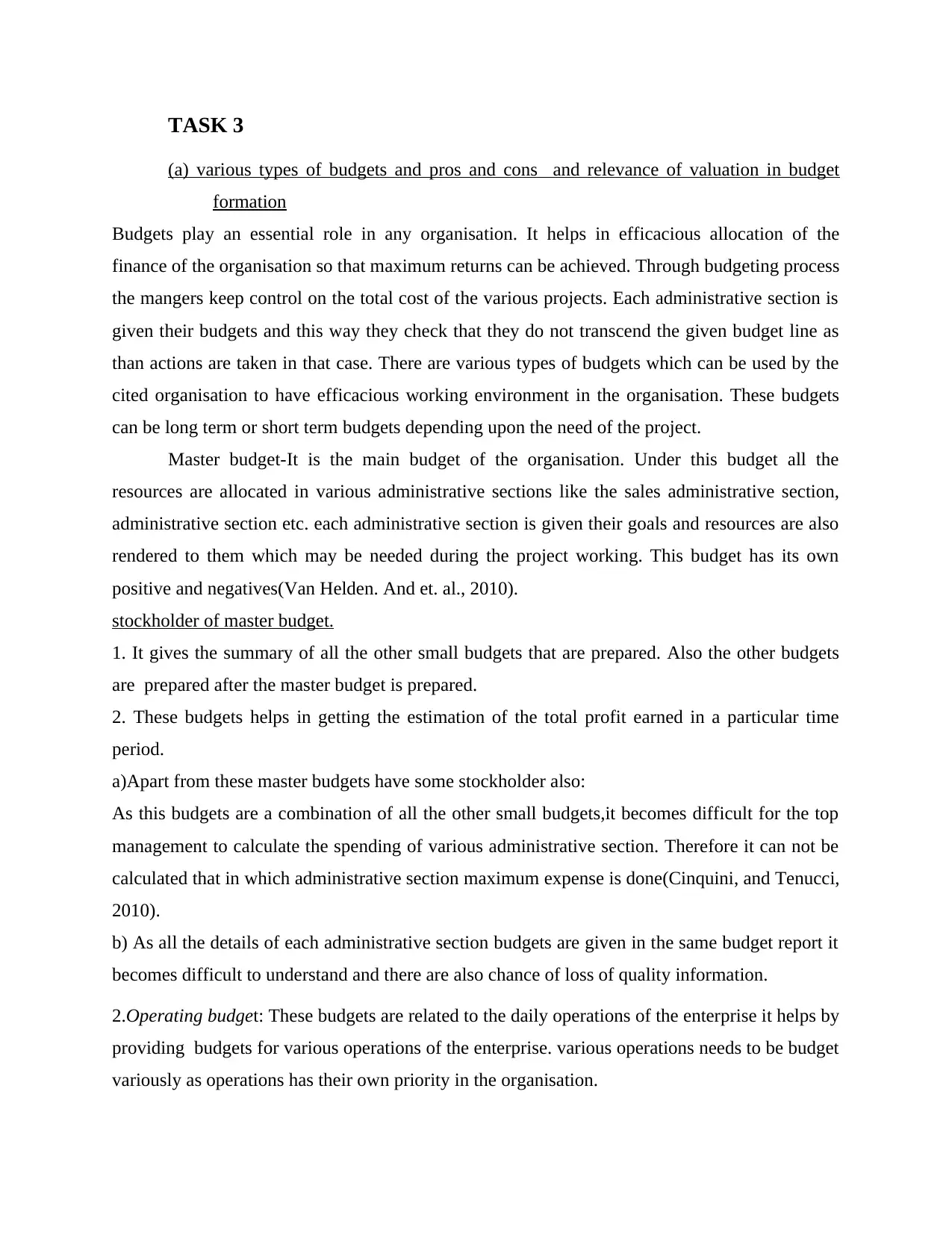
TASK 3
(a) various types of budgets and pros and cons and relevance of valuation in budget
formation
Budgets play an essential role in any organisation. It helps in efficacious allocation of the
finance of the organisation so that maximum returns can be achieved. Through budgeting process
the mangers keep control on the total cost of the various projects. Each administrative section is
given their budgets and this way they check that they do not transcend the given budget line as
than actions are taken in that case. There are various types of budgets which can be used by the
cited organisation to have efficacious working environment in the organisation. These budgets
can be long term or short term budgets depending upon the need of the project.
Master budget-It is the main budget of the organisation. Under this budget all the
resources are allocated in various administrative sections like the sales administrative section,
administrative section etc. each administrative section is given their goals and resources are also
rendered to them which may be needed during the project working. This budget has its own
positive and negatives(Van Helden. And et. al., 2010).
stockholder of master budget.
1. It gives the summary of all the other small budgets that are prepared. Also the other budgets
are prepared after the master budget is prepared.
2. These budgets helps in getting the estimation of the total profit earned in a particular time
period.
a)Apart from these master budgets have some stockholder also:
As this budgets are a combination of all the other small budgets,it becomes difficult for the top
management to calculate the spending of various administrative section. Therefore it can not be
calculated that in which administrative section maximum expense is done(Cinquini, and Tenucci,
2010).
b) As all the details of each administrative section budgets are given in the same budget report it
becomes difficult to understand and there are also chance of loss of quality information.
2.Operating budget: These budgets are related to the daily operations of the enterprise it helps by
providing budgets for various operations of the enterprise. various operations needs to be budget
variously as operations has their own priority in the organisation.
(a) various types of budgets and pros and cons and relevance of valuation in budget
formation
Budgets play an essential role in any organisation. It helps in efficacious allocation of the
finance of the organisation so that maximum returns can be achieved. Through budgeting process
the mangers keep control on the total cost of the various projects. Each administrative section is
given their budgets and this way they check that they do not transcend the given budget line as
than actions are taken in that case. There are various types of budgets which can be used by the
cited organisation to have efficacious working environment in the organisation. These budgets
can be long term or short term budgets depending upon the need of the project.
Master budget-It is the main budget of the organisation. Under this budget all the
resources are allocated in various administrative sections like the sales administrative section,
administrative section etc. each administrative section is given their goals and resources are also
rendered to them which may be needed during the project working. This budget has its own
positive and negatives(Van Helden. And et. al., 2010).
stockholder of master budget.
1. It gives the summary of all the other small budgets that are prepared. Also the other budgets
are prepared after the master budget is prepared.
2. These budgets helps in getting the estimation of the total profit earned in a particular time
period.
a)Apart from these master budgets have some stockholder also:
As this budgets are a combination of all the other small budgets,it becomes difficult for the top
management to calculate the spending of various administrative section. Therefore it can not be
calculated that in which administrative section maximum expense is done(Cinquini, and Tenucci,
2010).
b) As all the details of each administrative section budgets are given in the same budget report it
becomes difficult to understand and there are also chance of loss of quality information.
2.Operating budget: These budgets are related to the daily operations of the enterprise it helps by
providing budgets for various operations of the enterprise. various operations needs to be budget
variously as operations has their own priority in the organisation.
Paraphrase This Document
Need a fresh take? Get an instant paraphrase of this document with our AI Paraphraser
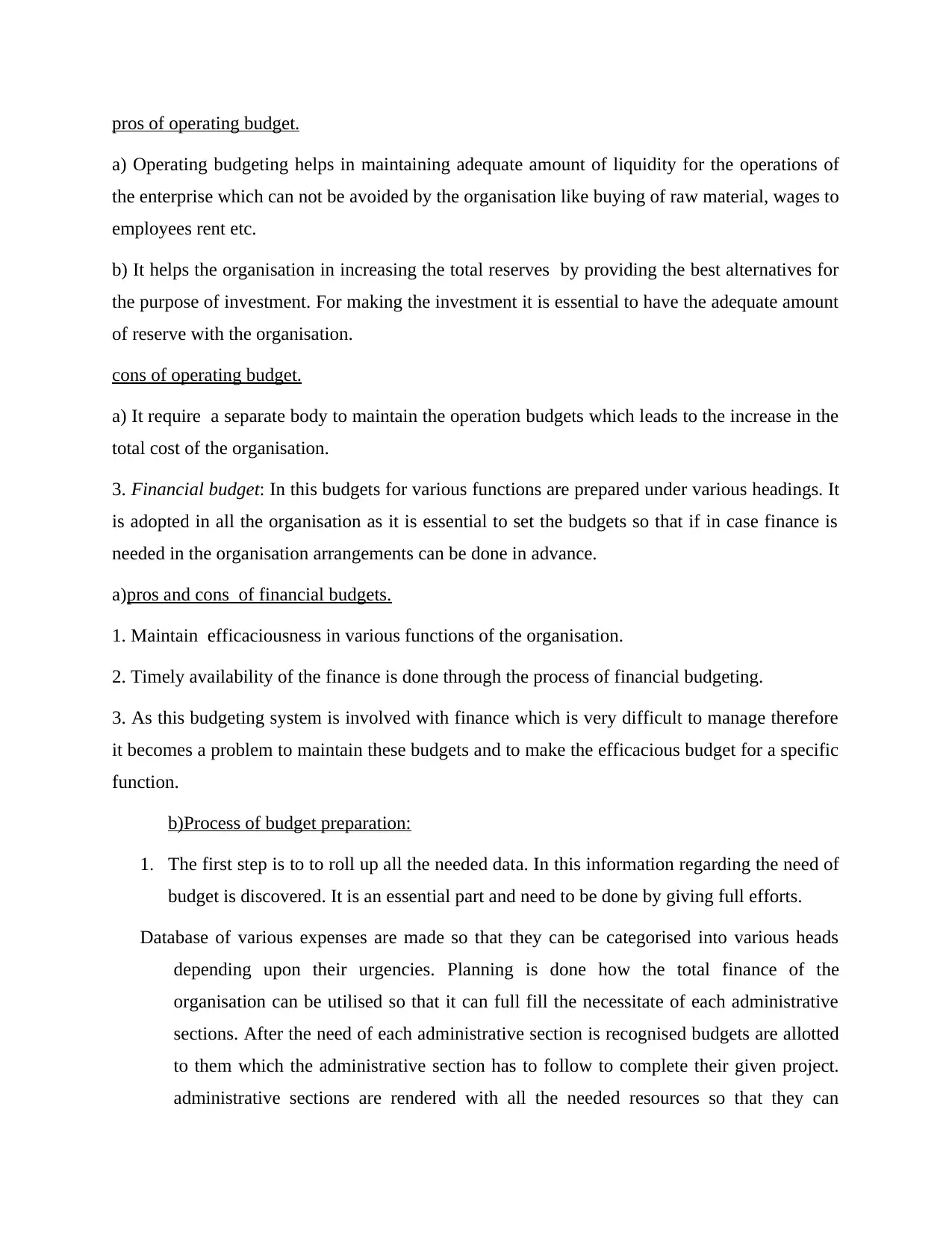
pros of operating budget.
a) Operating budgeting helps in maintaining adequate amount of liquidity for the operations of
the enterprise which can not be avoided by the organisation like buying of raw material, wages to
employees rent etc.
b) It helps the organisation in increasing the total reserves by providing the best alternatives for
the purpose of investment. For making the investment it is essential to have the adequate amount
of reserve with the organisation.
cons of operating budget.
a) It require a separate body to maintain the operation budgets which leads to the increase in the
total cost of the organisation.
3. Financial budget: In this budgets for various functions are prepared under various headings. It
is adopted in all the organisation as it is essential to set the budgets so that if in case finance is
needed in the organisation arrangements can be done in advance.
a)pros and cons of financial budgets.
1. Maintain efficaciousness in various functions of the organisation.
2. Timely availability of the finance is done through the process of financial budgeting.
3. As this budgeting system is involved with finance which is very difficult to manage therefore
it becomes a problem to maintain these budgets and to make the efficacious budget for a specific
function.
b)Process of budget preparation:
1. The first step is to to roll up all the needed data. In this information regarding the need of
budget is discovered. It is an essential part and need to be done by giving full efforts.
Database of various expenses are made so that they can be categorised into various heads
depending upon their urgencies. Planning is done how the total finance of the
organisation can be utilised so that it can full fill the necessitate of each administrative
sections. After the need of each administrative section is recognised budgets are allotted
to them which the administrative section has to follow to complete their given project.
administrative sections are rendered with all the needed resources so that they can
a) Operating budgeting helps in maintaining adequate amount of liquidity for the operations of
the enterprise which can not be avoided by the organisation like buying of raw material, wages to
employees rent etc.
b) It helps the organisation in increasing the total reserves by providing the best alternatives for
the purpose of investment. For making the investment it is essential to have the adequate amount
of reserve with the organisation.
cons of operating budget.
a) It require a separate body to maintain the operation budgets which leads to the increase in the
total cost of the organisation.
3. Financial budget: In this budgets for various functions are prepared under various headings. It
is adopted in all the organisation as it is essential to set the budgets so that if in case finance is
needed in the organisation arrangements can be done in advance.
a)pros and cons of financial budgets.
1. Maintain efficaciousness in various functions of the organisation.
2. Timely availability of the finance is done through the process of financial budgeting.
3. As this budgeting system is involved with finance which is very difficult to manage therefore
it becomes a problem to maintain these budgets and to make the efficacious budget for a specific
function.
b)Process of budget preparation:
1. The first step is to to roll up all the needed data. In this information regarding the need of
budget is discovered. It is an essential part and need to be done by giving full efforts.
Database of various expenses are made so that they can be categorised into various heads
depending upon their urgencies. Planning is done how the total finance of the
organisation can be utilised so that it can full fill the necessitate of each administrative
sections. After the need of each administrative section is recognised budgets are allotted
to them which the administrative section has to follow to complete their given project.
administrative sections are rendered with all the needed resources so that they can
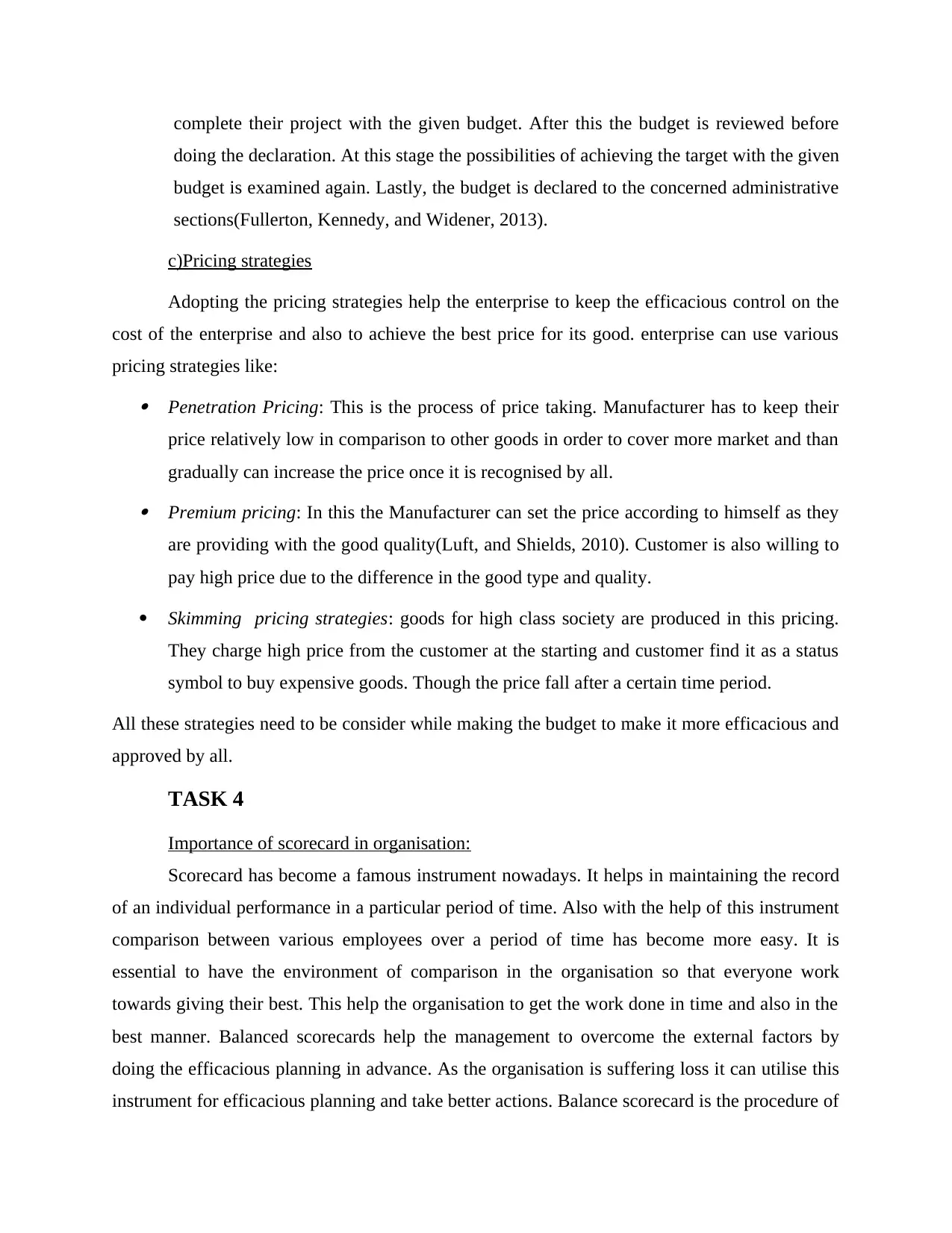
complete their project with the given budget. After this the budget is reviewed before
doing the declaration. At this stage the possibilities of achieving the target with the given
budget is examined again. Lastly, the budget is declared to the concerned administrative
sections(Fullerton, Kennedy, and Widener, 2013).
c)Pricing strategies
Adopting the pricing strategies help the enterprise to keep the efficacious control on the
cost of the enterprise and also to achieve the best price for its good. enterprise can use various
pricing strategies like: Penetration Pricing: This is the process of price taking. Manufacturer has to keep their
price relatively low in comparison to other goods in order to cover more market and than
gradually can increase the price once it is recognised by all. Premium pricing: In this the Manufacturer can set the price according to himself as they
are providing with the good quality(Luft, and Shields, 2010). Customer is also willing to
pay high price due to the difference in the good type and quality.
Skimming pricing strategies: goods for high class society are produced in this pricing.
They charge high price from the customer at the starting and customer find it as a status
symbol to buy expensive goods. Though the price fall after a certain time period.
All these strategies need to be consider while making the budget to make it more efficacious and
approved by all.
TASK 4
Importance of scorecard in organisation:
Scorecard has become a famous instrument nowadays. It helps in maintaining the record
of an individual performance in a particular period of time. Also with the help of this instrument
comparison between various employees over a period of time has become more easy. It is
essential to have the environment of comparison in the organisation so that everyone work
towards giving their best. This help the organisation to get the work done in time and also in the
best manner. Balanced scorecards help the management to overcome the external factors by
doing the efficacious planning in advance. As the organisation is suffering loss it can utilise this
instrument for efficacious planning and take better actions. Balance scorecard is the procedure of
doing the declaration. At this stage the possibilities of achieving the target with the given
budget is examined again. Lastly, the budget is declared to the concerned administrative
sections(Fullerton, Kennedy, and Widener, 2013).
c)Pricing strategies
Adopting the pricing strategies help the enterprise to keep the efficacious control on the
cost of the enterprise and also to achieve the best price for its good. enterprise can use various
pricing strategies like: Penetration Pricing: This is the process of price taking. Manufacturer has to keep their
price relatively low in comparison to other goods in order to cover more market and than
gradually can increase the price once it is recognised by all. Premium pricing: In this the Manufacturer can set the price according to himself as they
are providing with the good quality(Luft, and Shields, 2010). Customer is also willing to
pay high price due to the difference in the good type and quality.
Skimming pricing strategies: goods for high class society are produced in this pricing.
They charge high price from the customer at the starting and customer find it as a status
symbol to buy expensive goods. Though the price fall after a certain time period.
All these strategies need to be consider while making the budget to make it more efficacious and
approved by all.
TASK 4
Importance of scorecard in organisation:
Scorecard has become a famous instrument nowadays. It helps in maintaining the record
of an individual performance in a particular period of time. Also with the help of this instrument
comparison between various employees over a period of time has become more easy. It is
essential to have the environment of comparison in the organisation so that everyone work
towards giving their best. This help the organisation to get the work done in time and also in the
best manner. Balanced scorecards help the management to overcome the external factors by
doing the efficacious planning in advance. As the organisation is suffering loss it can utilise this
instrument for efficacious planning and take better actions. Balance scorecard is the procedure of
⊘ This is a preview!⊘
Do you want full access?
Subscribe today to unlock all pages.

Trusted by 1+ million students worldwide
1 out of 16
Related Documents
Your All-in-One AI-Powered Toolkit for Academic Success.
+13062052269
info@desklib.com
Available 24*7 on WhatsApp / Email
![[object Object]](/_next/static/media/star-bottom.7253800d.svg)
Unlock your academic potential
Copyright © 2020–2025 A2Z Services. All Rights Reserved. Developed and managed by ZUCOL.





